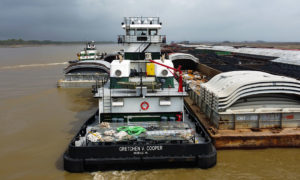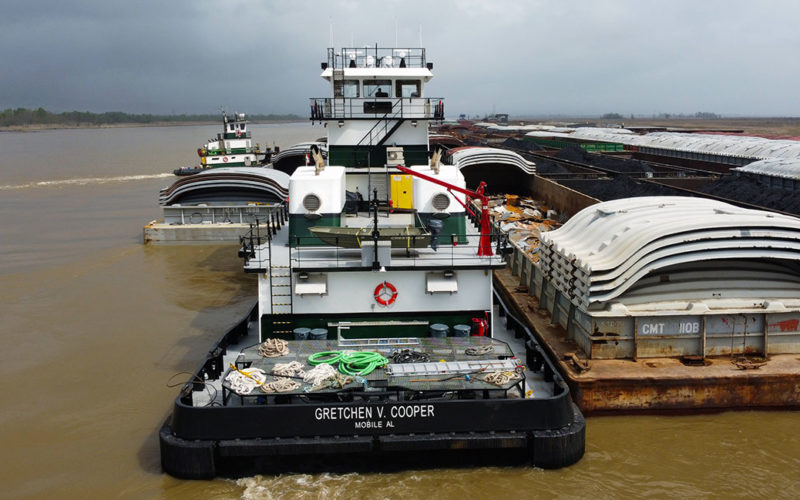
Cooper Marine & Timberlands is now operating one of the most environmentally friendly linehaul towboats on the inland waterways.
The company, based in Mobile, Ala., took delivery of Gretchen V. Cooper this spring from Blakeley BoatWorks. It is one of the first linehaul towboats in the United States with engines that meet EPA Tier 4 emissions standards, and the first with Caterpillar high-speed engines.
James Fowler, managing director of marine and stevedoring operations for Cooper Marine & Timberlands, considers the vessel an investment for the future. “And clearly the future is reduced carbon emissions,” he said in a recent interview at the company’s headquarters.
With 3,400 total horsepower, Gretchen V. Cooper is one of the fastest and most powerful towboats operating on the Tennessee-Tombigbee Waterway. “It has exceeded our expectations in performance, speed and safe handling in our river system,” Fowler said.
Farrell & Norton Naval Architects developed a new design for the 110-by-33-foot towboat. It tows up to eight barges, the limit for locks on the Tenn-Tom. It has primarily worked on that waterway since delivery; but, like other Cooper Marine vessels, it can work virtually anywhere within the inland river system.
Gretchen V. Cooper is the 20th towboat in the Cooper Marine fleet, which also has more than 400 dry cargo barges. The company is a division of the privately held Cooper/T. Smith. The 115-year-old company has multiple maritime businesses that include pushboat operator Plimsoll Marine and ship-assist company Crescent Towing. Blakeley BoatWorks is another subsidiary.
Cooper Marine’s newest, most environmentally friendly towboat is named for the wife of company President Angus R. Cooper III.
Gretchen V. Cooper joins a small number of towboats that meet the most stringent EPA emissions regulations. The deadline for meeting Tier 4 for marine engines exceeding 804 hp took effect in 2017. Even so, grandfathering provisions within the regulation have allowed shipyards to deliver one Tier 3 towboat after another over the past four-plus years.
The emissions reductions required under Tier 4 are significant. Engines that meet the standard nearly eliminate nitrogen oxide (NOx) and particulate matter (black soot) emissions. Caterpillar and most other major engine makers use an off-engine selective catalytic reduction (SCR) module requiring urea to meet these standards. GE, which uses an on-engine system to cut emissions, is the lone exception.
All options were on the table as Cooper Marine launched the Gretchen V. Cooper project. The company has experience with different engine makers across its maritime businesses and has experienced pros and cons with many of them. “In terms of this project,” Fowler said, “Cat was the best fit for us as we jumped off into Tier 4.”
There are several reasons why operators have been slow to embrace Tier 4 technology. Higher building costs are one, and the cost of buying urea in perpetuity is another. Sourcing urea also can be difficult in some smaller ports, and crews must be trained to handle the chemical as well.
These hurdles, as Cooper Marine has learned, can be overcome. The company partnered with its existing Mobile bunker supplier, Radcliff/Economy Marine Services, to supply urea to Gretchen V. Cooper. Caterpillar and local Cat dealer Thompson Tractor provided support before, during and after construction. Caterpillar also helped train Cooper’s crews, who have since passed along that knowledge to other companies, Fowler said.
Richard Tremayne, marine business manager for Thompson Tractor, said Tier 4 engines are more efficient than their Tier 3 counterparts, reducing overall fuel consumption. The fuel savings more than offset the cost of urea. Many other challenges often associated with Tier 4 engines similarly have been addressed, he said.
“The Cat Tier 4 engine has the same dimensions and weight as the prior tier engines, so the installation is the same as before,” Tremayne said. “Speaking to our shipyard customers, the early challenge each of them faced was conceiving where to locate the emissions module for each engine. The naval architects fairly quickly conquered that challenge for each vessel design.”
Cooper Marine had some important performance objectives for Gretchen V. Cooper that went well beyond the propulsion package. The vessel had to be maneuverable and responsive when navigating the narrow, winding Tenn-Tom, Fowler said. It also needed sufficient power to make those voyages quickly and safely in all river conditions. And, it had to maintain an 8.5-foot working draft.
The vessel is equipped with four flanking rudders and two steering rudders on each side. Its typical tow configuration is two rows of three barges ahead of the towboat, and one on its port and starboard sides. The 33-foot beam allows for flush lines along the entire tow, naval architect Tom Farrell explained.
Farrell & Norton’s design contains some attributes of the firm’s existing 120-foot platform. But the overall plans were redrawn for the 110-foot envelope. The main engines are in the lower engine space, and the SCR modules are in the upper engine space, along with twin 2,050-gallon urea tanks. The ceiling in the upper engine space was raised by two feet to accommodate the SCR module and other equipment.
“We pretty quickly realized we’d have to step up that aft 01 deck to get all the equipment in there and have room for the crew to work on it,” Farrell said.
The propulsion package on Gretchen V. Cooper consists of twin Cat 3512E engines producing 1,700 hp at 1,800 rpm. The main engines turn 88-inch, four-blade stainless-steel Southeastern Propellers through Twin Disc reduction gears. Ship service power comes from two 99-kW Cat C4.4 gensets installed forward of the main engines.
Interior spaces aboard the new vessel were designed with crew comfort in mind. The main deck has a storage area, a laundry room and a crew lounge with a large TV and leather furniture. There is an open-concept mess and galley with stainless-steel appliances. The engineer’s cabin, with connected head and a separate half-bath, also is on this level.
The 01 deck has four cabins in all, with two on each side separated by shared baths in the center of the tug. The 02 deck has the captain’s cabin and head. A Mitsubishi split system provides heating – and, more importantly, cooling that’s plenty robust for the blistering Alabama heat.
“For the crew, it is a very spacious vessel,” Fowler said. “The break room is really a theater room and a place for them to relax when they are off watch. In terms of accommodations, it really sets the bar for us and other linehaul operators.”
The 03 deck contains the wheelhouse with floor-to-ceiling windows facing forward and a 33.5-foot height of eye. The space is equipped with Furuno navigation electronics, a Furuno bridge navigation watch alarm, a Ritchie compass and Twin Disc controls. There are two Patterson 40-ton deck winches on the bow, while the hull and push knees are protected by fendering from Schuyler Companies.
Blakeley BoatWorks, formerly C&G Boat Works, built the vessel at its 26-acre shipyard along the Mobile River. Cooper/T. Smith acquired the yard in 2015 and has since used the facility for fleet upgrades and new construction, including an ongoing series of 70-foot fleet boats for Plimsoll Marine.
One of those vessels, the 1,600-hp Virginia, was the first newbuild in the United States to earn a certificate of inspection (COI) under Coast Guard Subchapter M in early 2019. Farrell & Norton designed that vessel and its three sister tugs, including Mary Lynn Cooper delivered in fall 2020.
Fowler, whose duties include overseeing the shipyard, said it has shown a knack for innovation and problem-solving during these complex builds. The yard has stayed busy building and repairing vessels for Cooper/T. Smith, but it could build vessels for other operators sometime down the road.
“We want to specialize in high quality,” Fowler said. “Especially with these sorts of jobs that require a special touch and level of attention, that is Blakeley’s sweet spot.”
It’s also possible the yard will find itself building a sister to Gretchen V. Cooper before long. Based on early reviews, it will be a tough act
to follow.

